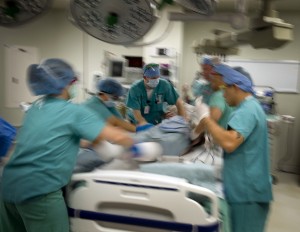
California stands to reap tens of thousands of jobs because of the federal health care overhaul -- according to a new report [PDF] by the Bay Area Council Economic Institute (BACEI).
Researchers compared the state’s 2010 workforce to what it might have been if the Affordable Care Act had been fully implemented in that year. They concluded that once the ACA is fully in place in 2014 almost 99,000 new jobs will be created as a result of the law, most of them in Southern California. The Sacramento Valley will see the largest increase rate: a 1.3 percent boost in job opportunities.
But ironically, health care jobs are not always healthy for the worker. Odd hours, ergonomics, and environmental factors contribute to specific risks for hospital and clinic workers.
By its nature health care is a 24-hour enterprise. Dr. Catherine Lau works nights almost exclusively as director of Nighttime Hospitalist Service at the UC San Francisco Medical Center. In an interview Lau said that while she appreciates the quiet, it can be "a little disorienting" to work at night in a windowless space. Shift-working nurses show higher rates of breast cancer, obesity and type 2 diabetes.
Nurses, physical therapists, and other health care workers push, pull, reach, bend, lift, and carry – and too often from positions and postures that challenge good body mechanics. Nursing aides, orderlies, and attendants are four times more likely to be injured on the job than the average worker in the United States. The California Safe Patient Handling Act regulates the lifting and transfer of hospital patients, however, it has been in effect less than year – not long enough to measure improvements.